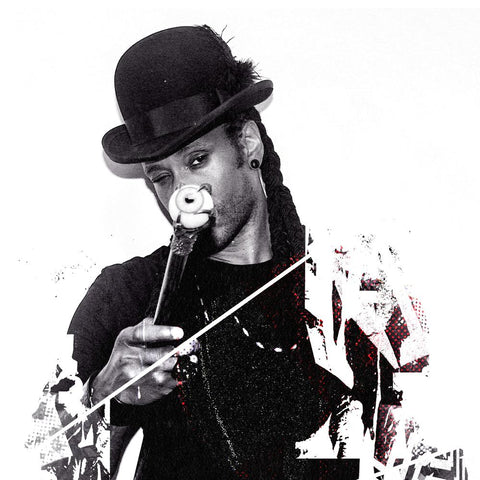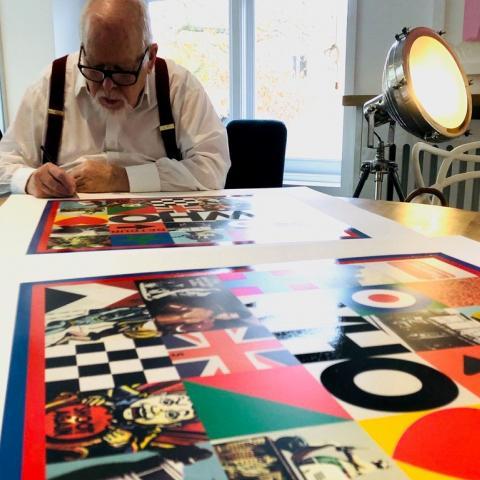by Alex Hall
The union flag has served a multitude of purposes in pop culture in a small amount of time amongst the overlapping worlds of art, fashion and music. How did the symbol of our national identity become so central to artistic expression in Britain over several decades? Just as it once signified ruling the waves on its way to colonise new shores, it succeeded in colonising culture too.
(Small Union Flag Glitter by Peter Blake)
You can find mass-produced handbags with the union flag on it in markets across the world, and just last year Louis Vuitton produced a handbag with the print on it to celebrate Meghan and Harry’s wedding. We want to explore the journey this iconic symbol has made over time, and where it is right now. It’s been quite a ride.

(Louis Vuitton’s design celebrating Meghan and Harry’s wedding)
The Swinging Sixties
In the Swinging Sixties, the union flag fluttered ecstatically as England won the world cup in 1966. It was then a symbol of joyous Englishness, adopted by Twiggy and Mini Cooper, to stylishly represent our country with pride. Very quickly, the union flag became a symbol of effortless British cool.

(Twiggy)
When Pete Townsend from The Who wore a real union jack flag as a jacket for his photoshoot with the Observer in 1966, it was clear that us Brits had a lot more freedom (ironically) than the Americans to use our flag in whatever way we wanted.
All of a sudden, we had The Beatles, Carnaby Street and David Bowie all swept up in this new symbol of Britishness. It was ironic, but not. It was nationalism and rebellion at the same time. It was a statement of individual swagger but also a collective identity. There was an optimism in the air, a sincere pride in being English without being racist. It was cool, it looked good and it became iconic for all of the right reasons.
The 1970s
During the 1970s, Skinheads and the National Front used the flag to symbolise their racism and violence. Expressed in football chants: “There ain’t no black in the union flag, send the bastards back.” The British Punk scene responded to this by using the flag to symbolise anarchy, rebellion, and a general ‘fuck you’ to the establishment and nationalism.
The Sex Pistols’ iconic torn up Union Flag held together by safety pins was everywhere for their debut single ‘Anarchy in the UK’ in 1976. A similar aesthetic was carried through all of their artwork, including the album art for ‘God Save the Queen’. It was a typically British sarcastic pisstake of patriotism, and did well to make the emergence of the flag being used by neo-nazis look ridiculous.
(Anarchy in the UK by Jamie Reid)
Brit Pop
Fast-forward to the 90s where we have the heights of Brit Pop. The union flag by this point had become void of any political significance, and was prime for being used as a worldwide marketing tool.

(David Bowie in Alexander McQueen, 1996 / Geri Halliwell at the Brits, 1997 / Kate Moss in John Galliano 1993)
The symbol became divorced from its origin and now became a global icon. Great Britain was determined to be seen as the epicentre of music as the rest of the world marvelled at Geri Halliwell in her homemade tea towel union flag dress, Liam Gallagher in his union flag bedspread, and Morrisey draped in the flag. It was a fun-loving, cheeky commercialisation that secured Britain’s space in popular culture as an artistic force to be reckoned with. The era of ‘Brand Britain ‘ and ‘Cool Britannia’ began.
Artists such as Peter Blake continue to be inspired by the energy and fun of this era, overlaying prints of the union flag with glitter.

(Noel and Liam Gallagher)
Brexit Britain
Now in a post-Brexit Britain, the concept of a ‘union’ flag seems more abstract than ever. When Stormzy took to the Pyramid stage last year, the first black male solo artist to headline Glastonbury in its forty-nine year history, he wore a union flag emblazoned gun vest that Banksy created.
(Stormzy at Glastonbury wearing a gun vest by Banksy)
A historic rebuttal to the ‘no black in the union flag’ chant, a black man at the apex of his success wearing a black and white union flag created by one of the most infamous artists in the world.
The art represented a huge moment in British culture, celebrating diversity whilst utilising the visual power of the symbol in a fresh way. It is a darker chapter for the graphic history of the union flag, using mournful monochromatic tones on a gun safety vest. Recognising the loss prevalent in our current times, of our freedom of movement, of our national identity as far-right politics become increasingly mainstream.
The journey of the union flag has come full circle from the 1970s, once again being used as a symbol for anti-establishment rebellion against a backdrop of daunting revitalised nationalism.
Union Grenade by Maxim
(Union Grenade by Maxim)
The Prodigy's MC and now established visual artist, Maxim has continued to subvert the symbolism of the union flag in his work. The limited edition print entitled Union Grenade features a battalion of grenades containing glowing hearts, against a backdrop of a black and white union flag. His work frequently explores the darker side of the imagination, but it feels particularly powerful at this precise moment.
As hate crime in Britain increases and racial tensions heighten with class divisions, Maxims work is a stirring reminder of the power of compassion. As so much of our political discourse has become injected with fear and hatred, the real rebellion and ferocity that we have lies with our empathy. Its empowering, electric and visually stunning. The antithesis to ‘Broken Britain’, the art that we need right now, Maxim has created something to be inspired by whilst addressing our current times. A bit of a firestarter, if you like.
Available exclusively at Enter Gallery, we’re excited to announce that 10% of profits from the Union Grenade prints will be donated to The Stephen Lawrence Charitable Trust. A charity set up in Stephen’s memory to inspire young people from disadvantaged backgrounds, enabling them to succeed in the career of their choice. They also work to create a fairer society in which everyone, regardless of their background, can flourish.











